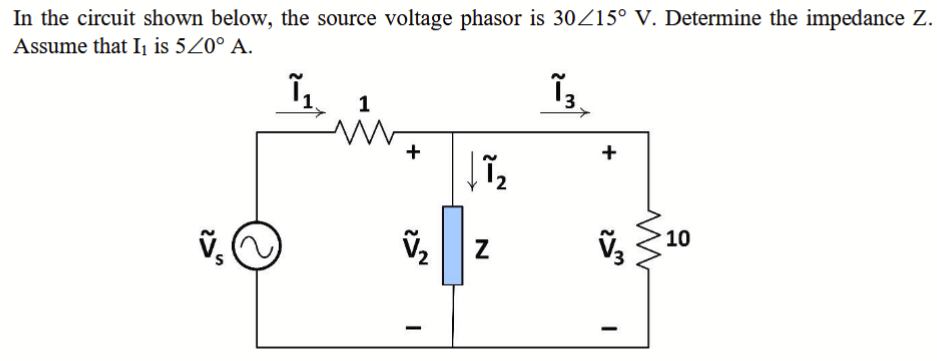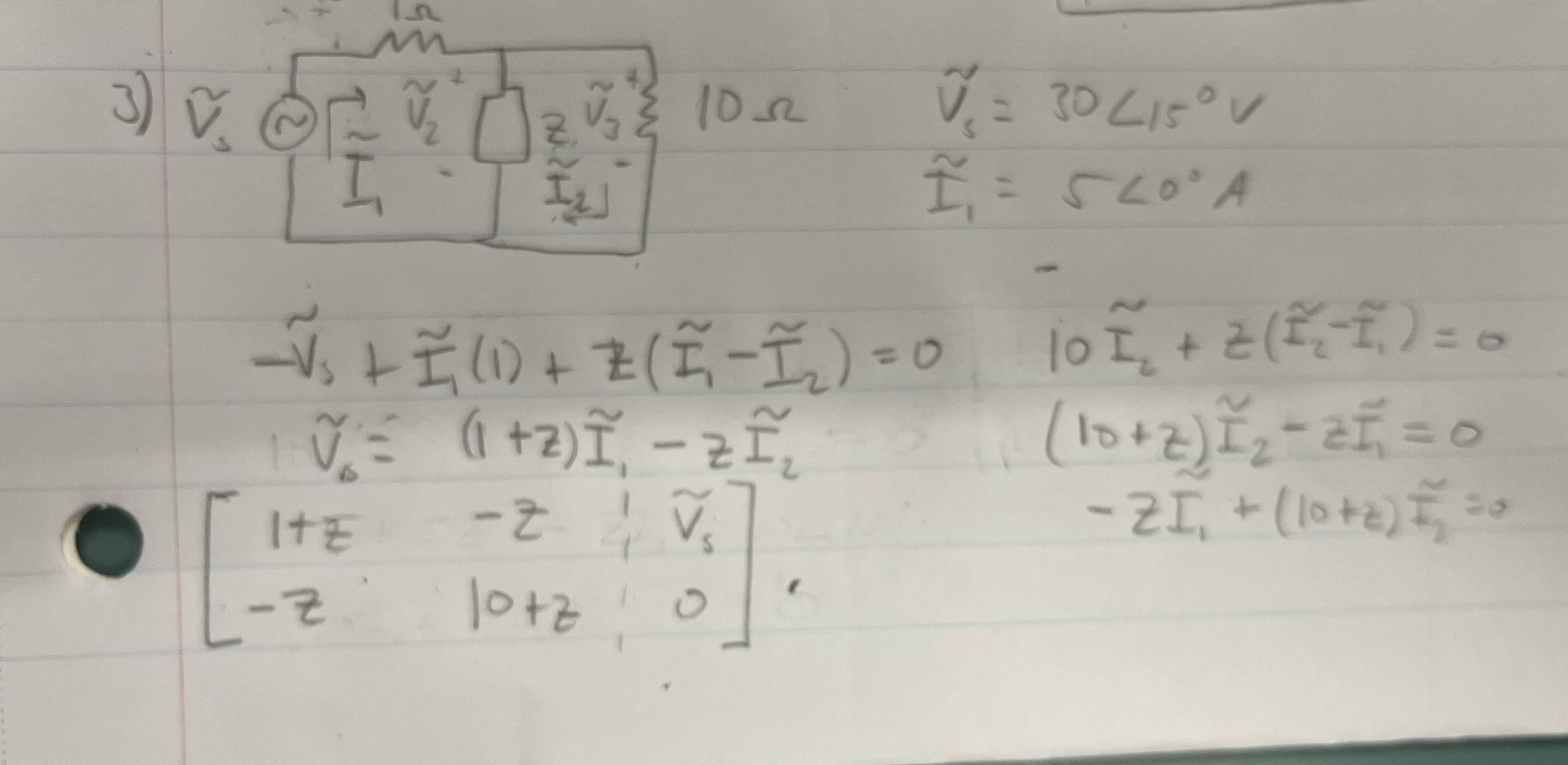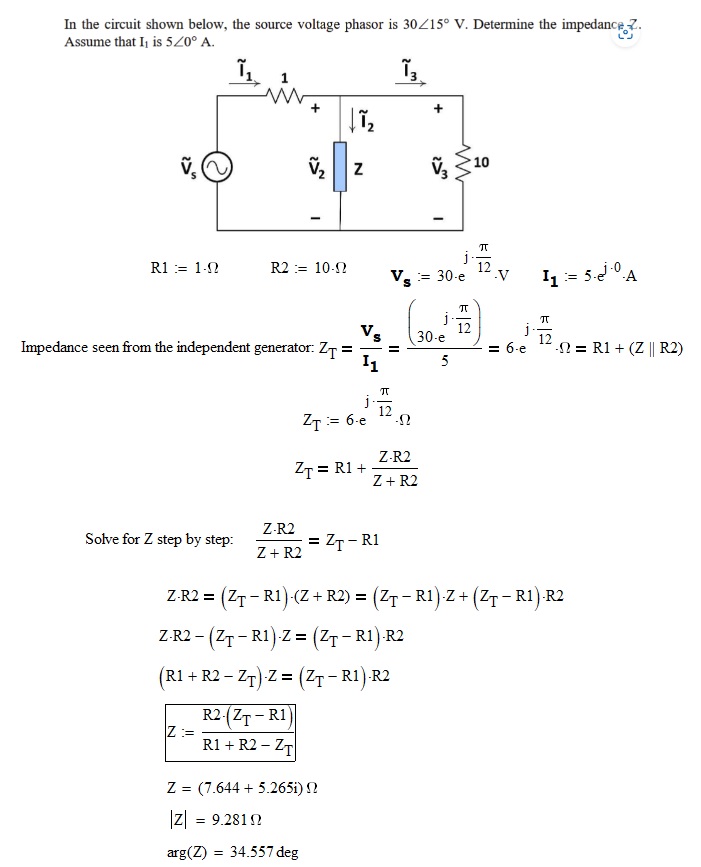Well, in general we know that:
$$\underline{\text{V}}=\underline{\text{I}}\cdot\underline{\text{Z}}\tag1$$
When the absolute value and argument of a current, voltage and/or impedance are given, we need to take a look at the following formula's:
- $$\left|\underline{\text{V}}\right|=\left|\underline{\text{I}}\cdot\underline{\text{Z}}\right|=\left|\underline{\text{I}}\right|\cdot\left|\underline{\text{Z}}\right|\tag2$$
- $$\arg\left(\underline{\text{V}}\right)=\arg\left(\underline{\text{I}}\cdot\underline{\text{Z}}\right)=\arg\left(\underline{\text{I}}\right)+\arg\left(\underline{\text{Z}}\right)\tag3$$
Where I used easily proviable equalities for the absolute values and arguments of complex numbers.
Now, we apply this to your problem. Let's first take a look at the argument:
$$\arg\left(\underline{\text{V}}_{\space\text{s}}\right)=\arg\left(\underline{\text{I}}_{\space1}\right)+\arg\left(\underline{\text{Z}}_{\space\text{i}}\right)\space\Longrightarrow\space15^\circ=0^\circ+\arg\left(\underline{\text{Z}}_{\space\text{i}}\right)\space\Longleftrightarrow\space\arg\left(\underline{\text{Z}}_{\space\text{i}}\right)=15^\circ\tag4$$
The fact that the argument of the impedance is between \$0^\circ\$ and \$90^\circ\$, we can conclude that:
$$\Re\left(\underline{\text{Z}}_{\space\text{i}}\right)>0\space\wedge\space\Im\left(\underline{\text{Z}}_{\space\text{i}}\right)>0\tag5$$
So, the argument of the impedance is given by:
$$\arg\left(\underline{\text{Z}}_{\space\text{i}}\right)=\arctan\left(\frac{\Im\left(\underline{\text{Z}}_{\space\text{i}}\right)}{\Re\left(\underline{\text{Z}}_{\space\text{i}}\right)}\right)=15^\circ\space\Longleftrightarrow\space\frac{\Im\left(\underline{\text{Z}}_{\space\text{i}}\right)}{\Re\left(\underline{\text{Z}}_{\space\text{i}}\right)}=2-\sqrt{3}\tag6$$
Using formula \$(2)\$, we can see that:
$$\left|\underline{\text{V}}_{\space\text{s}}\right|=\left|\underline{\text{I}}_{\space1}\right|\cdot\left|\underline{\text{Z}}_{\space\text{i}}\right|\space\Longrightarrow\space30=5\cdot\left|\underline{\text{Z}}_{\space\text{i}}\right|\space\Longleftrightarrow\space\left|\underline{\text{Z}}_{\space\text{i}}\right|=\sqrt{\Re^2\left(\underline{\text{Z}}_{\space\text{i}}\right)+\Im^2\left(\underline{\text{Z}}_{\space\text{i}}\right)}=6\space\Omega\tag7$$
We can see that:
$$
\begin{alignat*}{1}
\underline{\text{Z}}_{\space\text{i}}&=\text{R}_1+\left(\text{R}_2\space\text{||}\space\underline{\text{Z}}\right)\\
\\
&=\text{R}_1+\frac{\displaystyle\text{R}_2\cdot\underline{\text{Z}}}{\displaystyle\text{R}_2+\underline{\text{Z}}}\\
\\
&=\text{R}_1+\frac{\displaystyle\text{R}_2\left(\Re\left(\underline{\text{Z}}\right)+\Im\left(\underline{\text{Z}}\right)\text{j}\right)}{\displaystyle\text{R}_2+\Re\left(\underline{\text{Z}}\right)+\Im\left(\underline{\text{Z}}\right)\text{j}}\\
\\
&=\text{R}_1+\frac{\displaystyle\text{R}_2\left(\Re\left(\underline{\text{Z}}\right)+\Im\left(\underline{\text{Z}}\right)\text{j}\right)}{\displaystyle\text{R}_2+\Re\left(\underline{\text{Z}}\right)+\Im\left(\underline{\text{Z}}\right)\text{j}}\cdot\frac{\displaystyle\text{R}_2+\Re\left(\underline{\text{Z}}\right)-\Im\left(\underline{\text{Z}}\right)\text{j}}{\displaystyle\text{R}_2+\Re\left(\underline{\text{Z}}\right)-\Im\left(\underline{\text{Z}}\right)\text{j}}\\
\\
&=\text{R}_1+\frac{\displaystyle\text{R}_2\left(\Re\left(\underline{\text{Z}}\right)+\Im\left(\underline{\text{Z}}\right)\text{j}\right)\left(\text{R}_2+\Re\left(\underline{\text{Z}}\right)-\Im\left(\underline{\text{Z}}\right)\text{j}\right)}{\displaystyle\left(\text{R}_2+\Re\left(\underline{\text{Z}}\right)\right)^2+\Im^2\left(\underline{\text{Z}}\right)}\\
\\
&=\text{R}_1+\frac{\displaystyle\text{R}_2\Re^2\left(\underline{\text{Z}}\right)+\text{R}_2\Im^2\left(\underline{\text{Z}}\right)+\text{R}_2^2\Re\left(\underline{\text{Z}}\right)+\text{R}_2^2\Im\left(\underline{\text{Z}}\right)\text{j}}{\displaystyle\left(\text{R}_2+\Re\left(\underline{\text{Z}}\right)\right)^2+\Im^2\left(\underline{\text{Z}}\right)}\\
\\
&=\text{R}_1+\frac{\displaystyle\text{R}_2\Re^2\left(\underline{\text{Z}}\right)+\text{R}_2\Im^2\left(\underline{\text{Z}}\right)+\text{R}_2^2\Re\left(\underline{\text{Z}}\right)}{\displaystyle\left(\text{R}_2+\Re\left(\underline{\text{Z}}\right)\right)^2+\Im^2\left(\underline{\text{Z}}\right)}+\frac{\displaystyle\text{R}_2^2\Im\left(\underline{\text{Z}}\right)}{\displaystyle\left(\text{R}_2+\Re\left(\underline{\text{Z}}\right)\right)^2+\Im^2\left(\underline{\text{Z}}\right)}\cdot\text{j}\\
\\
&=\underbrace{\text{R}_1+\frac{\displaystyle\text{R}_2\left(\text{R}_2\Re\left(\underline{\text{Z}}\right)\left(1+\Re\left(\underline{\text{Z}}\right)\right)+\Im^2\left(\underline{\text{Z}}\right)\right)}{\displaystyle\left(\text{R}_2+\Re\left(\underline{\text{Z}}\right)\right)^2+\Im^2\left(\underline{\text{Z}}\right)}}_{\space:=\space\Re\left(\underline{\text{Z}}_{\space\text{i}}\right)}+\underbrace{\frac{\displaystyle\text{R}_2^2\Im\left(\underline{\text{Z}}\right)}{\displaystyle\left(\text{R}_2+\Re\left(\underline{\text{Z}}\right)\right)^2+\Im^2\left(\underline{\text{Z}}\right)}}_{\space:=\space\Im\left(\underline{\text{Z}}_{\space\text{i}}\right)}\cdot\text{j}
\end{alignat*}
\tag8
$$
Where \$\displaystyle\alpha\space\text{||}\space\beta:=\frac{\displaystyle\alpha\beta}{\displaystyle\alpha+\beta}\$.
So, using \$(5)\$, \$(6)\$, \$(7)\$ and \$(8)\$ we can set-up a system of equations:
$$
\begin{cases}
\begin{alignat*}{1}
6&=\sqrt{\Re^2\left(\underline{\text{Z}}_{\space\text{i}}\right)+\Im^2\left(\underline{\text{Z}}_{\space\text{i}}\right)}\\
\\
2-\sqrt{3}&=\frac{\Im\left(\underline{\text{Z}}_{\space\text{i}}\right)}{\Re\left(\underline{\text{Z}}_{\space\text{i}}\right)}\\
\\
\Re\left(\underline{\text{Z}}_{\space\text{i}}\right)&>0\\
\\
\Im\left(\underline{\text{Z}}_{\space\text{i}}\right)&>0
\end{alignat*}
\end{cases}\space\Longleftrightarrow\space\begin{cases}
\Re\left(\underline{\text{Z}}_{\space\text{i}}\right)=3\left(2+\sqrt{3}\right)\sqrt{2-\sqrt{3}}\\
\\
\Im\left(\underline{\text{Z}}_{\space\text{i}}\right)=3\sqrt{2-\sqrt{3}}
\end{cases}\tag9
$$
And solve for \$\Re\left(\underline{\text{Z}}\right)\$ and \$\Im\left(\underline{\text{Z}}\right)\$:
$$\Re\left(\underline{\text{Z}}\right)\approx7.64351\space\wedge\space\Im\left(\underline{\text{Z}}\right)\approx5.26451\tag{10}$$
The exact values are:
$$\Re\left(\underline{\text{Z}}\right)=\frac{10 \left(36981375 \sqrt{2}+1275 \left(20293 \sqrt{2}+20724\right) \sqrt{3}-10816931\right)}{197063761}\tag{11}$$
$$\Im\left(\underline{\text{Z}}\right)=\frac{150 \left(2103684-450433 \sqrt{2}+574992 \sqrt{3}+1818217 \sqrt{6}\right)}{197063761}\tag{12}$$
I used Mathematica to solve this. The code is provided below:
In[1]:=Clear["Global`*"];
x = 1 + ((10*(a + b*I))/(10 + a + b*I));
\[Alpha] = FullSimplify[ComplexExpand[Re[x]]];
\[Beta] = FullSimplify[ComplexExpand[Im[x]]];
FullSimplify[
Solve[{6 == Sqrt[\[Alpha]^2 + \[Beta]^2],
2 - Sqrt[3] == \[Beta]/\[Alpha], a > 0 && b > 0}, {a, b}, Reals]]
Out[1]={{a -> (10 (-10816931 + 36981375 Sqrt[2] +
1275 Sqrt[3] (20724 + 20293 Sqrt[2])))/197063761,
b -> (150 (2103684 - 450433 Sqrt[2] + 574992 Sqrt[3] +
1818217 Sqrt[6]))/197063761}}
In[2]:=N[%1]
Out[2]={{a -> 7.64351, b -> 5.26451}}




solve(Eq(simplify(solve([Eq(vs-r1*ia-z3*(ia-ib),0),Eq(-z3*(ib-ia)-r2*ib,0)],[ia,ib])[ia]).subs({ r1:1, r2:10, vs:complex(*(solve([Eq(atan2(y,x),15/180*pi),Eq(sqrt(x**2+y**2),30)],[x,y])[0])) }),5),z3)[0]. Sympy reports:7.64350779569818 + 5.26451039777369*IBut this is also \$9.28107113 \:\angle 34.5573534^\circ\$. \$\endgroup\$